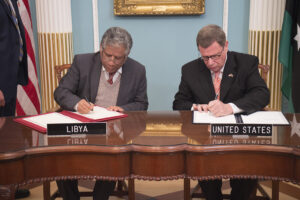
On February 23, Under Secretary of State for Public Diplomacy and Public Affairs I. Steven Goldstein and Libyan Ministry of Foreign Affairs Under Secretary for Political Affairs Lutfi Almughrabi signed the first bilateral Memorandum of Understanding on cultural property protection at a ceremony at the U.S. Department of State’s Treaty Room. U.S. Government photo.
In July 2022, the Cultural Property Advisory Committee (CPAC) at the Department of State heard testimony from the Committee for Cultural Policy, Global Heritage Alliance, the Association of Art Museum Directors, numismatic organizations and groups representing the interests of Jewish refugees from the Middle East and North Africa opposing a request by the Libyan government to renew US import restrictions on art and artifacts from 12,000 BCE to 1911.
The Libyan request for renewal, which would extend a 2018 Memorandum of Understanding (MOU) is now pending before CPAC. The proposed 5-year renewal is controversial for many reasons, among them that:
- The original Libyan agreements of 2017-2018 were pushed through by the State Department without Congressionally mandated public comment and signed with a fragmented ‘government’ that was a mere faction in an ongoing civil war and could not uphold the terms of an agreement.
- Libya is still enmeshed in a civil war and has no effective national government.
- Libyan archaeological sites and built heritage are being destroyed, not protected, by the factions fighting in Libya.
- Much of Libya’s heritage loss is due to illegal land development tolerated by local governments, not to an international market for looted Libyan artifacts.
- Libya desperately needs funding for domestic heritage inventories and documentation, salaries for heritage workers, disaster prevention for sites, museums, and archives, and a directed public campaign to explain the importance of history and preservation of heritage to the Libyan people, especially young people – not a renewed MOU.
- The current Libyan request fails to meet the four key legal criteria set by Congress for import restrictions under the 1983 Cultural Property Implementation Act.
- Libya is an abuser of human, social, religious, and community rights – not a valid partner with the United States in the protection of global cultural interests that we avow.
- The current US agreement should not be renewed because it denies rights to heritage of religious minorities driven from the country. Libya continues to nationalize or destroy the remaining community and private property of Libyan Christians and Jews. (An article detailing State Department complicity in Libya’s appropriation and destruction of Jewish and Christian heritage also appears in this month’s Cultural Property News)
A summary of the Committee for Cultural Policy and Global Heritage Alliance testimony follows:
The original cultural property agreement with Libya in 2017 improperly denied the public comment and failed to meet legal requirements of the Cultural Property Implementation Act (CPIA).
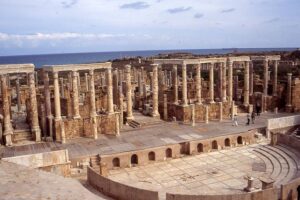
Leptis Magna – Labdah, Libya, Author G. Sludge, November 2004, CC-SA 4.0 International license, Wikimedia Commons.
On Monday July 3, 2017, the State Department’s Cultural Heritage Center published a Federal Register Notice of a CPAC meeting to consider a request for an import blockade on art from Libya to be heard just 16 days later. Unless members of the public submitted written comments within 7 days – including the Fourth of July long weekend – they would not be allowed to testify on the proposed MOU.
In response, the Association of Art Museum Directors (AAMD) described the timing in 2017 as “unseemly” and stated that, “vetting it in this abbreviated fashion could compromise ever-important public trust in the Committee and its mission.”[1] There was clearly no emergency; Libya had admitted the “threats” to its cultural heritage had existed for “at least the last six years and in some instances for decades.”
The AAMD said that asking for import restrictions on virtually every item made over a 13,000 year period from 12,000 BC to 1750 AD [2] was “nothing short of vast” and that “granting it would strain, if not shatter credulity.” It reminded CPAC that archaeological materials must be of “cultural significance and that ethnological material must have “distinctive characteristics,” be of “comparative rarity” or contribute “to the knowledge of the origins, development, or history.” The scope of the Libyan request, stated the AAMD, “eradicates any notion of protecting only “culturally significant”[3] items”[4] as set forth in the statute.
The Libyan request in 2017 was one of the first all-encompassing import restrictions covering virtually all objects made by human hands – yet five years later, such broad restrictions have become commonplace.[5] Despite there being no evidence that all items made during this 13,000 year period were at risk of looting or that they were ‘significant’ or that there was even a U.S. market for them, as the statute required. Instead, a virtually all-encompassing Designated List of objects prohibited from import was enacted. With the 2022 Libyan renewal request, the CPAC committee is again being asked to violate the standards set by Congress for what kinds of items can be blocked from U.S. import, and in what circumstances.
Libya has no government to honor and implement an MOU. It was in chaos in 2017 when emergency restrictions were put in place and it is still in chaos.

This rebel pick-up truck at Ajdabiya had a four-barreled Grad missile launcher mounted on the back, 23 April 2011, CCA-SA 2.0 Generic license. Wikimedia Commons.
Libya has been in a state of civil war since the overthrow of the Ghaddafi government in 2011. Attempts to bring the parties together have failed again and again. In December 2015, a unified government was announced, known as the Government of National Accord (GNA). Within a week, this ‘unified’ government was rejected by General Haftar, who leads the so-called Libyan National Army, backed by the population in eastern Libya. By late 2016, there were three main governments centered around Tripoli, Tobruk in the east and the UNESCO-backed GNA. Part of the south of the country is now controlled by the National Movement for Tuaregs.
Despite claims by various factions that things are settling down, there has been no end to bombardments, with tens of thousands of airstrikes on cities and antique built heritage and on areas surrounding major monuments and archaeological sites.
A half dozen foreign nations are supplying the different Libyan factions with arms despite an ostensible embargo; the power plays between these nations contribute significantly to the failure to find peace, although many Libyan citizens would now accept almost any solution that ended the decade long civil war.
Last year, in 2021, the GNA was replaced by another interim Government of National Unity (GNU) created largely through the efforts of the United Nations. The Libyan National Army officially ceded power to the GNU in March 2021, but there is not actual unity or stability; the factions continue to struggle against one another in an endless tug-of-war. On July 22, 2022, a week before the hearing on renewal of the MOU, the GNU government dominant in Tripoli broke into factions and serious fighting broke out between them inside the city; according to press reports, the situation is “worsening.”[6]

Russian fighter aircraft arrived in Libya, from an airbase in Russia, after transiting Syria where it is assessed they were repainted to camouflage their Russian origin. “The world heard Mr. Haftar declare he was about to unleash a new air campaign. That will be Russian mercenary pilots flying Russian-supplied aircraft to bomb Libyans,” said U.S. Army Gen. Stephen Townsend, commander, U.S. Africa Command. 25 May 2020, Public domain.
The US Department of State, 2021 Trafficking in Persons Report: Libya paints a frightening portrait of life in Libya today and over the duration of the 2017-2018 MOU:
“Libya is a Special Case for the sixth consecutive year. The Libyan Government of National Accord (GNA) struggled to govern large swaths of Libyan territory, as it did not exercise control in several parts of the country. The judicial system was not fully functioning, as courts in major cities throughout the country have not been operational since 2014. Violence continued … due to the conflict between the Tripoli-based GNA and the self-styled Libyan National Army (LNA), which has sought to establish a rival government in eastern Libya. Financial or military contributions from other states in the region further enabled the conflict, with Turkey supporting the GNA and Russia, the United Arab Emirates, and Egypt supporting the LNA… Extra-legal armed groups continued to fill a security vacuum across the country… These disparate groups committed various human rights abuses, including unlawful killings, forcible recruitment, forced labor, and sex trafficking. Impunity for those committing abuses against civilians was a pervasive problem… the GNA and GNA-aligned armed groups recruited and used child soldiers; the international organization also verified the LNA and LNA-aligned armed groups recruited and used child soldiers…[C]riminal networks, militia groups, government officials, and private employers exploited migrants, refugees, and asylum-seekers in sex and labor trafficking. Endemic corruption and militias’ influence over government ministries contributed to the GNA’s inability to effectively address human trafficking.” [7]
Archaeological work, preservation, museum activities, inventory management and conservation in Libya are at a virtual standstill. Libya’s cultural sector and its two separate Departments of Antiquities cannot operate in a state of civil war in which warring factions consider ‘cultural heritage’ of little account.
A year prior to the 2017 hearing on the first Libya MOU, an international workshop was held in 2016 in Tunis to support heritage activities in Libya.[8] However, as British archaeologist Paul Bennett reported in Libyan Studies, the annual journal of the Society for Libyan Studies[9]:
“Despite the efforts of UNESCO, ICCROM and others over the past five years, including the Society, to cooperate with Libyan institutions to provide training and support, the worsening situation now requires a wider framework to provide urgent and immediate protection for archaeological sites, even those with World Heritage status, a longer term strategy for cultural heritage generally.”[10]

Ruins east church, Apollonia (Susah), Libya, Author Maher 27777, 16 January 2010, Public domain.
The conferees set forth important needs and goals for Libyan cultural heritage. Conference attendees were clear that to meet the crisis, there needed to be inventories done of materials and site documentation, satellite imagery organized for condition assessment, protection and disaster measures put in place for sites, museums, archives and stores, compilation of a list of missing and stolen artifacts to share with the international community, a national inventory of built heritage created using GIS mapping and satellite imagery, measures taken to fight against illegal encroachments and building in and around sites, against illicit trade, and campaigns to raise public awareness of Libyan heritage, particularly for young people.
However, in the years that followed, there was virtually no action taken toward achieving these goals, due to the lack of high-level Libyan government support.
Up to today, and over the last five years during which the MOU has been in place, these remain aspirational goals. To quote Paul Bennett of the Society for Libyan Studies, “All the outcomes set out above represent the hopes and aspirations of our Libyan colleagues, and we hope with help from the international community, as we move towards peace and good governance in the country, all our colleagues’ aspirations will become a reality.”[11]
Unfortunately, government indifference, negligence, and lack of funding have left heritage authorities unable to even begin to take the self-help measures required for a bilateral agreement under the CPIA.
As Bennett notes repeatedly in the annual Notes from Libya published in Libyan Studies up to 2020, much of the work accomplished in Libya since 2017 has been done instead by committed local officials and heritage specialists who command the respect of the communities where sites are located. This has involved clearing brush and removing litter and garbage from World Heritage sites and negotiating with developers intent on building shops right up to the walls of major monuments. One of the most active groups has been the Boy Scouts, an organization whose membership is not limited to youth in Libya, which has organized cleanup and protection campaigns and done much to raise awareness of heritage among local populations. Nonetheless, this volunteer work is inherently limited and no substitute for government action.[12]
The lack of interest by Libyan government factions and the fighting at and around heritage sites has resulted in serious deterioration and damage to Libyan archaeological sites and built heritage.
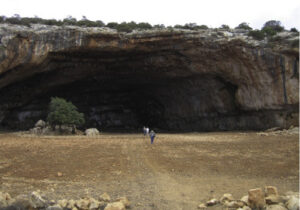
Haua Fteah cave looking south across the doline floor into the caver. Author Graeme Barker, 1 January 2014, CCA 3.0 Unported license, Wikimedia Commons.
Haua Fteah Cave. An archaeological project undertaken in north-east Libya during the period of the MOU involved sifting of tons of soil gathered in excavations from Haua Fteah Cave in Cyrenica. This important site for understanding North African prehistory was originally excavated beginning in 1951. Excavation was made to14 meters depth; the earliest finds were tiny flake and blade artifacts dating 65,000 to 80,000 years. Training provided in Britain enabled more recent work sieving sediments through flotation and preparation of cave for eventual additional excavation. By 2016 the main hope was to backfill the site to protect it. In 2017, the Society for Libyan Studies was finally able to get 5000 € in funding from the Prince Claus Fund to backfill the site.[13] The site was lined with geotextile and the different layers were shored up. During this work, there was deteriorating security because cave was located close to front lines between the Libyan army and IS. The archaeologists were driven out several times by explosions and gunfire nearby.
Cyrene World Heritage site. In 2015, the Department of Antiquities in Cyrene was unable to prevent escalating illegal development for housing and agricultural land in and around Shahat and even within the World Heritage Site of Cyrene that destroyed significant parts of the ancient Necropolis. The situation around Al-Bayda was reported to be a little better in 2018, “but knowledgeable people are nor optimistic at all,” according to archaeologist Paul Bennett. In the Cyrene suburbs, archaeologists reported in 2018 that new buildings had been illegally built within the site of Cyrene and all along the ancient tomb-lined road to Al Baida and in Wadi Belgadir. According to Paul Bennett in 2018, “there is new, uncontrolled and illegal development everywhere” and “all the ancient cemetery sites surrounding Cyrene must now be considered at risk.”[14]
The site controller was able to work with the Benghazi Department of Antiquities (DoA) to remove vegetation from the site and secure some tombs near the highway to prevent vandalism. “Local farmers are now actively discouraged from bringing animals on the site.”[15]

Apollonia, Libya, Central church, Author VEdi Fonte, 8 January 2008, Wikimedia Commons.
Apollonia. A new housing estate constructed 2017-2018 has destroyed the East Fort, a rock cut fortress. Another such fort was also recently destroyed west of the port. The ancient port is now surrounded by housing and sewage is being discharged into the sea, in some cases at the ancient port itself. The ancient natural reef protecting the port has severely deteriorated, weakening the port’s resistance to damage from the sea.[16]
Al Baida. Building on the campus of the University of Al Baida exposed a Late Roman building with mosaic pavements. Salvage archaeology was carried out to preserve a record of the building – before it was destroyed.[17]
Built heritage of Old Benghazi. The Medina Gadima (Old City) of Benghazi “has been devastated, with parts barely recognizable, being simply a mass of collapsed buildings.”[18] According to Paul Bennett, 40-50,000 families were displaced by the fighting and by 2020, no arrangements had been made to repair the structures or provide alternative housing.[19]
Sidi Khrebish. “The archaeological site has been badly disturbed by multiple burials of Islamist fighters.”[20]
Tocra. In 2017-2018 “A significant amount of coastal erosion has occurred…with further loss of stratified deposits and building foundations.” “A scheme to fence the site has apparently failed through lack of funds; the intention was to install concrete posts purchased some years ago… the wire was in store ready to be used.”[21]

The ancient desert town of Ghadames, Libya, is designed to fight the dramatic extremities of Saharan climate. Houses are made out of mud, lime, and palm tree trunks with covered alleyways between them. Author Luca Galuzzi – www.galuzzi.it, 7 April 2007.
Site of Eusperides. In 2017: “The site has been mined and is a no-go area.”[22] In 2018: Benghazi Football Club or its owners were seeking to develop 140 shops in part of the harbor and Lower City of Esperides. Paul Bennett noted that “…the open ground north of existing high rise flats and south-east of the Football Club, despite extensive piles of domestic and industrial rubbish dumped after 2000, even today retains visible traces of a complex pattern of streets dating back before the mid-third century BC.” After much lobbying by local cultural activists, in 2019 the Football club agreed to modify the plan and fence the adjacent ancient site, building the shops nearby but not on the ancient site itself.[23]
Training Excavations. Local universities have conducted several short training excavations at Balagrae and Tocra.[24] In 2018, the University of Benghazi cancelled a planned training excavation for Libyan students from all universities due to lack of funds; by 2020 some trainings had taken place.[25]
Ghadames. “Warfare, neglect and recent very bad weather have had a marked effect on parts of the city. A number of co-dependent buildings have collapsed, jeopardizing the stability of adjacent properties.”[26] BP funding was denied but was hoped to be re-applied for. In December 2018, the American Ambassador’s Fund was asked for help, but did not provide it.[27]
Tripoli. In March 2019, the French Archaeological Mission put forward a scheme to restore the National Museum in Tripoli. ALIPH (International Alliance for the Protection of Heritage) funding was sought. ALIPH later agreed to provide some funding for training and restoration at five World Heritage sites, beginning with Ghadames.
Libya’s two competing Departments of Antiquities are struggling to function.
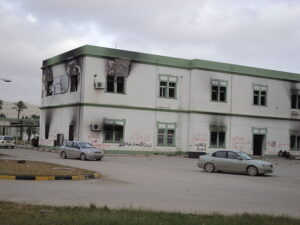
Inside relatively undamaged Al-Fadeel battalion compound at Berka. 2011, Benghazi, Libya, Author Maher27777, March 2011. Public domain.
Libya not only lacks a government capable of administrative management, or of protecting Libyan materials that would be returned to it as a result of a MOU with the United States. The fracturing of power and authority has resulted in their being two Departments of Antiquities (DoAs), one in Tripoli and one in Benghazi. UNESCO only recognizes the one in Tripoli. Unfortunately, the two DoAs have a poor history of working together and are usually at odds. In 2017 archaeologist Paul Bennett stated:
“There is still conflict between the two Departments of Antiquities and the situation between them is not encouraging at all, despite the reality of disintegrating archaeological sites, illegal development everywhere and a growing market in the trafficking of antiquities. Sites are decreasing daily and destruction is everywhere.”[28]
In 2018, the Department of Antiquities (DoA) in Benghazi operated out of the former Berka Barracks, a large, late Ottoman (late 19-early 20th C) complex made up of “decaying, partially collapsed buildings surrounding a parade ground.” The DoA was formerly in a school building at Sidi Khrebish, but in 2007, “with bulldozers at the site entrance,” it was forced to remove the most important collections representing stratigraphic finds from mid-3rd C BCE to the 11th C CE to the town of Tocra for safekeeping.[29] Other archaeological materials from the Greek city site of Eusperides were taken to the Benghazi municipal ‘House of Culture’. According to Paul Bennett, “Other parts of the more modern collections (including a fine group of Jewish and Italian gravestones and Italian period sculptures) were lost to the bulldozer.”[30]
The Benghazi DoA later had to remove the Eusperides finds to Tocra, where the objects were said to be safe but poorly housed[31] and the DoA administration was moved, together with all its library, archives, including museum records, maps, plans and photographs to the former Italian Fish Market buildings in Benghazi. The Italian Fish Market buildings were then seriously damaged by shell and mortar strikes and it was thought that the archives had been completely lost. The materials stored in the basement were buried by debris when the building was destroyed.[32] Later in 2018, it appeared that some crates containing excavated materials from Eusperides had been in the same basement and some of these materials were recovered.
The Benghazi DoA now has no space other than the Berka Barracks. According to Paul Bennett in 2018, “there is no home for what is left of the salvaged library, archives and other materials. There is also a complete lack of resources to provide a new base of operations.”[33]
The Libyan request calls for return, but government authorities cannot protect returned items and the global public has no access to Libyan museums.
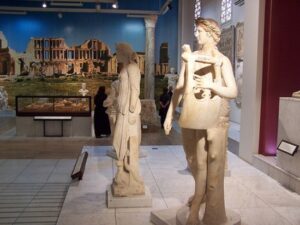
Roman sculptures in Red Castle Museum, Tripoli, 2012., Author Libiya11, 8 June 2012, CCA-SA 3.0 Unported license, Wikimedia Commons.
When the 2017-2018 MOU was enacted, all of Libya’s twenty-four museums were closed. While a few museums are now open in Tripoli for local visitors, international access is extremely limited. Both the U.S. and U.K. strongly advise against travel to Libya, advising, “Do not travel to Libya due to crime, terrorism, civil unrest, kidnapping, and armed conflict.”[34]
Libyan archaeologists stated in 2016 that items in museums were “safe,” but they were “safe” only because they had been hidden behind locked doors and camouflaged by furniture.[35] This is not safe. At the time, ICOM stated that it believed that Libyan museums were secure, but “there are no guarantees, as the country has not been considered safe enough to send people on the ground to assess the recent situation.”[36]
Basic educational infrastructure in Libya has been destroyed and must be completely rebuilt. The University of Benghazi is simply gone.
By 2017, as reported in Libyan Studies, not a single building at the large, relatively modern campus of the University of Benghazi, once attended by thousands of students, was left standing. The university site, which had become embroiled in fighting several times, was a wasteland with only a few blackened walls left.[37] Some classes were being held in satellite locations, such as nearby former women’s dorms, thanks to “the resilience and determination of teaching staff and students (and their parents)”, not the government.
Even getting books on archaeological subjects into Libya has been impossible. In 2015 with the assistance of the World Bank Multi-Donor Trust Fund, three thousand copies of the Arabic edition of Philip Kenrick’s Tripolitania (Libya Archaeological Guides) were printed to be circulated within the Department of Antiquities, and in schools and universities to try and build local support for archaeological work. However, there were so few university libraries or museums open to the public that there was no way to distribute them. Another publication done in 2020 in Arabic, Philip Kenrick’s Archaeological Guide to Cyrenaica, was hoped to be shipped into Libya with the help of the US Embassy in Tunis into Libya in July 2020.[38],[39]
Libya’s request for renewal fails to meet legal criteria under the 1983 Cultural Property Implementation Act.
The current Libyan request fails to meet the four key legal criteria set by Congress for import restrictions under the Cultural Property Implementation Act.
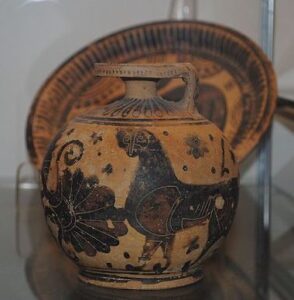
Ceramic, Tripoli Museum, Author Syed Wali Peeran, 18 January 2010, CC-SA 4.0 International license, Wikimedia Commons.
The current Libya Designated List is not based upon an analysis of facts identifying endangered sites or substantiating current looting required of CPAC by Congress under the Cultural Property Implementation Act. It covers everything from prehistoric lithic tools to Classical antiquities of the Roman period to Islamic furniture, brassware and calligraphy to nomadic herdsmen’s baskets and cooking pots – and everything in between.
The 2017-2018 Libyan MOUs did not distinguish between items of historical or archaeological importance and items that are common, repetitive, and that are found outside of archaeological contexts, such as Ottoman period and earlier Islamic artworks, Tuareg materials, and the artifacts of the now-exiled Jewish communities of Libya.
The statute requires that the Libyan government demonstrate that Libyan art from all the requested periods subject to import restrictions is in danger of looting.[40] In fact, on June 11, 2017, one year after UNESCO listed five archaeological sites in Libya on the endangered world heritage list, Libya’s General Tourism Authority (GTA) objected to the decision.[41] The five sites were Leptis Magna, the ancient city of Sabratha, Cyrene, the rock art site of the Akakus Mountain and Ghadames.
Unquestionably, these sites remain in danger today. However, the thefts and losses to heritage taking place today in Libya are due to the country being in an active civil war and through deliberate destruction by development unhampered by the Libyan governments.
Libya has largely failed to document and identify losses to heritage. On May 15, 2017, just prior to the first hearing on the Libyan MOU, Libya issued a list of items stolen from Libyan museums. One statue on the list was allegedly stolen during WW2.[42] This list has not been updated since.

Theater, Sabratha, Libya.
The Libyan government has not engaged in cultural exchanges with the U.S. in the five years since the MOU was first signed, neither through traveling exhibitions, museum loans, or providing digital online access Libyan art and artifacts. There is no demonstration that import restrictions sought are “consistent with the general interest of the international community in the interchange of cultural property” as the CPIA requires.[43] Indeed, the 2017 Libyan Request stated, “Sharing of our cultural heritage is not feasible at this time because the crisis situation of armed conflict, civil unrest, and terrorism threat makes it not feasible to work out collaborative arrangements with foreign partners.” Today, the crisis situation of armed conflict continues unabated.
The US market for legitimate Libyan artifacts is small. For illegal Libyan artifacts, it no longer exists. Antiquities sales in Libya are mostly local and inundated with fakes. There is not an active Western international market for looted Libyan artifacts. What market there is appears directed within the region, particularly the Middle East.
Finally, with respect to the statutory criteria for an MOU, there is no demonstrated current U.S. market for illegal Libyan art or artifacts, such that ending a market for pillaged artifacts would be of “substantial benefit in deterring a serious situation of pillage” as the statute requires.[44],[45] A repatriation ceremony was held in 2022 for the return of two statues from Cyrene in Libya that were stolen in Libya twenty-two years before and which had been exhibited for years at the Metropolitan Museum without a claim being made. The objects were from the Steinhardt collection; they had been seized in December 2021 by the Manhattan District Attorney and agreed to be forfeited.[46]
There is no legal or ethical justification for the inclusion of ethnological materials from Libya in a U.S. MOU restricting imports.
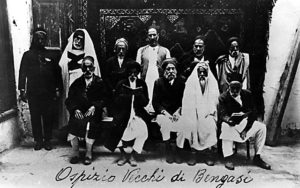
Jewish Old Age Home in Benghazi, Libya, 1900-1920, courtesy Beth Hatefutsoth Photo Archive.
The current Libyan MOU includes the private and community property of minorities driven out of Libya and forced to leave their possessions and property behind. Jewish and Christian religious artifacts are included in the Libyan MOU by default. Synagogues, cemeteries, and Christian religious monuments have been vandalized, destroyed, and repurposed into Muslim mosques and secular centers.
(For a discussion of Libyan claims to Jewish and Christian heritage, see Libyan Jewish Community Fights for Rights to Heritage, Cultural Property News, July 28, 2022.)
Under the current MOU, Libya claims ownership and control over nomadic Tuareg and Berber ethnological materials up to 1911, the date of Italian colonization. Only 15-20 thousand Tuareg live in Libya; approximately 2 million live in Niger, a country not subject to a U.S. MOU. Almost none of their ethnographic materials qualify for restriction under the standards in the CPIA contemplated by Congress. Of the 2903 items identified as Tuareg in the Musee du Quai Branly in Paris, one of the world’s largest and most comprehensive collections of Tuareg art and handicrafts, only four are from Libya: a tambourine, a talisman, and two photographs.
The items created and used by the nomadic Tuareg are household goods and decorative garments, bags, and jewelry that is subject to ordinary wear and tear. Because of this hard usage, there is very little Tuareg material culture remaining anywhere in Africa that is older that the late nineteenth century. This element of the Libyan Request in no respect comports with Congress’ criteria for restrictions on ethnographic materials of ‘particular meaning’ to a pre-industrial community as envisioned by the drafters of the CPIA.
Many Tuareg are traders by occupation, and the castes of artisans (blacksmiths, jewelers, etc.) have made and traded Tuareg goods to other Tuareg and to their Hausa, Falani (Wadabe) and other Saharan neighbors as a business for as long as there has been information available on Tuareg lifeways, in the late 19th century.

Tuareg souvenir vendor at Mafo Lake in the Libyann Sahara. Author David Stanley, Nanaimo, Canada.
The CPIA requires that restricted ethnographic material have some important character.[47] Tuareg ethnographic materials are common, repetitive, and it is impossible to date them precisely as made prior to 1911 (unlawful to import) or after 1911 (lawful to import), the cut-off date in the Libyan Request. Comparing the materials collected (as old) by European museums in the 1930s and 1940s, Kristyne Loughran, writing in “The Art of Being Tuareg,” Thomas Seligman and Kristyne Loughran, Eds. stated that, “Many of the forms they described in the past [19th century] still exist today, though some of the objects have become rare or are no longer used.”[48]
Finally, the legislative history of the CPIA shows that Congress did not contemplate coverage of the types of Jewish, Christian, Berber, or Tuareg personal and religious property requested by Libya. The legislative history makes clear that agreements under the CPIA were intended to apply only to a “narrow range of objects possessing certain characteristics,” not ordinary objects or trinkets.[49],[50]
Coins on the current Designated List do not meet criteria for import restrictions. The vast majority of coins struck in Libya are not exclusively or even primarily found in Libya, and they circulated much more widely in ancient times. The CPIA requires that coins and other items restricted under an MOU be “first discovered within and subject to export control by” the State Party.

Greek (Punic) coin, head of the goddess Libya wearing tiara, silver tetradrachm, ca. 400/350-250/200 BC, München, Staatliche Münzsammlung.
Despite failing to meet the statutory criteria, the Libyan Designated Lists issued December 5, 2017 and July 9, 2018 included many coins that circulated widely outside of Libya. We defer to the analysis by the International Association of Professional Numismatists (IAPN) submitted to CPAC July 14, 2022, which found that Greek silver and gold coins, Roman Imperial coins, Byzantine, Islamic and Ottoman coins, far from being exclusive to Libya, did not even meet the State Department’s recent self-imposed standard of “circulating primarily” in Libya. Any restrictions on these coins should be limited, per the statute, to coins “first discovered within, and subject to export control” by Libya.[51]
Cultural rights are inextricably tied to human rights. Human rights abuses are widely tolerated and even promoted by the Libyan government. Libya’s government cannot function as a valid partner with the United States in the protection of global cultural heritage when it denies its citizens and its significant immigrant population their human, social, religious, and community rights.
As stated in the U.S. Department of State, Office to Monitor and Combat Trafficking in Persons, “2021 Trafficking in Persons Report: Libya”:
“Perpetrators committing human rights abuses, including human trafficking crimes, generally operated with impunity. The government did not publicly report statistics on prosecutions or convictions of trafficking offenders, including government officials and government-aligned militias that were allegedly complicit in trafficking crimes. The government did not report if it prosecuted or convicted any individuals involved in the investigation of 205 suspected traffickers that the attorney general’s office initiated in 2018, nor did it report if any of the 35 arrest warrants that it issued in January 2019 resulted in trafficking prosecutions or convictions during the reporting period.”[52]
Recommendations
Libya is a failed state that cannot possibly meet the statutory requirements of the Cultural Property Implementation Act. A government that closes its eyes to continuing violations of international law and commits egregious crimes against humanity on this scale cannot meet the CPIA’s criteria for self-help as protectors of cultural rights and heritage. Nor can Libya guarantee the safety and security of objects returned to it under an MOU.
If CPAC insists on recommending an agreement with Libya, the only legal alternative under the CPIA would be to terminate the current MOU and implement Emergency restrictions only on site-specific objects exclusive to Libya that are subject to current looting and for which a demonstrated U.S. market exists.

Arch of Marcus Aurelius, a Roman triumphal arch in the city of Oea, modern Tripoli, near the Medina, Author Dr Esam Tabone, 21 March 2017, CC-SA 4.0 International license.
In the last five years the MOU has been in place, the factions fighting over Libya – when there has been a government at all – have ignored Libya’s cultural crisis. There are individuals in what was once Libya’s cultural sector who care deeply about preserving Libya’s great monuments and historical sites, but they can do almost nothing against government indifference to cultural loss. The Libyan archaeologists and cultural workers who remain are desperate to protect World Heritage sites from crumbling, and to keep locals from bulldozing through site boundaries for land to build on or graze animals. But the reports indicate that cultural workers get more help from volunteers such as Libya’s Boy Scouts than from its unstable governments.
The Committee for Cultural Policy and Global Heritage Alliance recognize that Libya continues to experience political upheavals, has chronically ineffectual local and national governance, massive corruption undermining the rule of law, the dominance of large areas of the country by militias and criminal gangs, and a destabilized economy. Under these circumstances, renewal of the MOU would undermine the credibility of every other government-to-government agreement under the Cultural Property Implementation Act.
If import restrictions on Libyan art and artifacts are to be continued, and can be justified under the facts, then the only lawful option is to enact unilateral emergency restrictions on the very limited types of artifacts meeting the “significance” criteria of the CPIA and which are actually subject to looting. Any emergency agreement should impose compulsory benchmarks for any continuing import restrictions requiring Libya to improve domestic protections for its cultural heritage and the cultural life of its people.
The Committee for Cultural Policy and Global Heritage Alliance suggest that in the absence of an MOU and on the request of the GNU, US museums could assist in the preservation of Libyan heritage by providing temporary safe harbor to Libyan objects. Such temporary safe harbor could also help to fulfill UNESCO State Parties’ obligation to compensate for the lack of access to Libyan materials by providing access to scholars and the public. The AAMD’s 2017 recommendation that US museums engage with Libyan cultural institutions to provide safe harbor to stolen objects has equal merit today, in 2022.
Kate Fitz Gibbon
Committee for Cultural Policy, Inc.
[1] Statement of the Association of Art Museum Directors Concerning the Request from the Government of Libya to the Government of the United States of America under Article 9 of the 1970 UNESCO Convention on the Means of Prohibiting and Preventing the Illicit Import, Export and Transfer of Ownership of Cultural Property, Association of Art Museum Directors, July 19, 2017, (henceforth AAMD Libya Statement 2017), 1.
[2] The request sought import restrictions on “stone, metal, ceramic and clay, glass, faience, and semi-precious stone, mosaic, painting, plaster, textile, basketry, rope, bone, ivory, shell and other organics,” Id. at 2.
[3] 19 U.S.C. § 2601(2)(c)(i)(I).
[4] AAMD Libya Statement 2017, 2
[5] The Afghanistan Designated List (2022) covers 50,000 BCE to 1920, Albania (2022) 3,000,000 BCE to 1913, Algeria (2019) 2.4 million BCE to 1750, Jordan (2020) 1.5 million BCE to 1750, etc.
[6] Several killed in clashes between Libyan security forces, July 22, 2022, Al-Jazeera, https://www.aljazeera.com/news/2022/7/22/several-dead-in-clashes-between-libyan-security-forces
[7] U.S. Department of State, Office to Monitor and Combat Trafficking in Persons, “2021 Trafficking in Persons Report: Libya,” https://www.state.gov/reports/2021-trafficking-in-persons-report/libya/
[8] ‘International Experts Meeting on Safeguarding Libyan Cultural Heritage’, organized by UNESCO, ICCROM, the US State Department and US Embassy and the Department of Antiquities of Libya, held in Tunis, 9–11 May, 2016.
[9] The Society for Libyan Studies has just been restructured as British Institute for Libyan & Northern African Studies. It is now part of the British International Research Institute, sponsored by the British Academy, located at the School of Archaeology at Oxford University. See: https://www.arch.ox.ac.uk/article/nick-barton-elected-inaugural-president-british-institute-libyan-and-north-african-studies.
[10] Paul Bennett, Notes from Libya, Libyan Studies 47 (2016), pp 181–184 © The Society for Libyan Studies
doi:10.1017/lis.2016.12 First published online 14 September 2016, https://doi.org/10.1017/lis.2016.12 Published online by Cambridge University Press.
[11] Id.
[12] Paul Bennett, Notes from Libya, Libyan Studies 49 (2018), p 217-218, © The Society for Libyan Studies
[13] Paul Bennet, Notes from Libya, Libyan Studies 47 (2016), pp 181–184 © The Society for Libyan Studies, doi:10.1017/lis.2016.12 First published online 14 September 2016, https://doi.org/10.1017/lis.2016.12 Published online by Cambridge University Press.
[14] Paul Bennett, Notes from Libya, Libyan Studies 49 (2018), p 212, © The Society for Libyan Studies
[15] Id. at 217.
[16] Id. at 216.
[17] Id.
[18] Id. at 221.
[19] Id. at 219-220.
[20] Id.
[21] Id. at 222.
[22] Id.
[23] Paul Bennett, Notes from Libya, Libyan Studies 50 (2019) p 189, © The Society for Libyan Studies
[24] Id. at 217.
[25] Paul Bennett, Notes from Libya, Libyan Studies 50 (2019) p 189, © The Society for Libyan Studies
[26] Paul Bennett, Notes from Libya, Libyan Studies 49 (2018), at 89.
[27] Paul Bennett, Notes from Libya, Libyan Studies 50 (2019) p 221
[28] Paul Bennett, Notes from Libya, Libyan Studies 48 (2017), at 175.
[29] Id. at 213.
[30] Id.
[31] Id. at 221
[32] Id.
[33] Id.
[34] The US government travel advisory website specifically suggests “Draft a will and designate appropriate insurance beneficiaries and/or a power of attorney. Discuss a plan with loved ones regarding care/custody of children, pets, property, belongings, non-liquid assets (collections, artwork, etc.), funeral wishes, and etcetera.”
https://travel.state.gov/content/travel/en/traveladvisories/traveladvisories/libya-travel-advisory.html
[35] “Looters exploit the political chaos in Libya,” The Art Newspaper, 10/20/2016, http://theartnewspaper.com/news/news/looters-exploit-the-political-chaos-in-libya/
[36] Ibid.
[37] Paul Bennett, Notes from Libya, Libyan Studies 49 (2018), p211, © The Society for Libyan Studies.
[38] Paul Bennett, Notes from Libya, Libyan Studies 50 (2019) p 190, © The Society for Libyan Studies
[39] Paul Bennett, Notes from Libya, Libyan Studies 51 (2020) p 183, © The Society for Libyan Studies
[40] 19 U.S.C. § 2602(c)(2)(B).
[41] Libya’s Antiquities Department refutes UNESCO report on Leptis Magna, August 7 2016, https://www.libyaobserver.ly/culture/libyas-antiquities-department-refutes-unesco-report-lepits-magna, Last visited July 18, 2022, and Libya rejects UNESCO’s decision to place five sites on endangered list,
https://www.libyaobserver.ly/culture/libya-rejects-unesco%E2%80%99s-decision-place-five-sites-endangered-list, last visited 07/09/2017.
[42] It had been on public exhibit at the Cleveland Museum of Art for more than 25 years but never been claimed by Libya. Libyan authorities issued an international circular on looted antiquities from Libya in 2017, but that page has not been updated and is now unavailable.
[43] 19 U.S.C. §§ 2602(a)(1)(D) and 2602(e)(1)
[44] 19 U.S.C. § 2602(c)(2)(B)
[45] In 2015, a Demeter/Persephone statue was attempted to be imported into the U.K. but was seized on entry. Imogen Calderwood, Government seizes 1,800-year-old looted statue of goddess Persephone worth £1.5million and vows to return it to Libya, Daily Mail September 1, 2015, https://www.dailymail.co.uk/news/article-3218733/Government-seizes-1-800-year-old-looted-statue-goddess-Persephone-worth-1-5million-vows-return-Libya.html
[46] Yousef Murad, US returns smuggled artifacts to Libya, AP, March 31, 2022, https://apnews.com/article/science-travel-lifestyle-libya-united-states-f95e10c4f84e4389c89cdebfd5e5a77f
[47] “No object may be considered to be an object of ethnological interest” unless the object is “important to the cultural heritage of a people because of its distinctive characteristics, comparative rarity, or its contribution to the knowledge of the origins, development, or history of that people.” 19 U.S.C. §2601(2)(C)(ii)(II).
[48] Seligman and Loughram state that the Tuareg “classical jewelry repertoire has remained remarkably stable over time.”[48] The traditional metal for Tuareg jewelry was a nickel/copper/zinc alloy (called “German silver” in the market, and “kobo” among the Tuareg) but coin silver was also used. About 45 years ago, sterling silver began to be used for jewelry, but kobo continues to be popular. Only in the last 20 years have there been dramatic changes in Tuareg jewelry design; it is often more delicate and less “tribal” in appearance than the fully traditional jewelry of the 1970s and 1980s. “The Art of Being Tuareg,” Thomas K. Seligman and Kristyne Loughran, Eds., UCLA Fowler Museum (February 2006)
[49] U.S. Senate Report, 97-564, “Implementing Legislation for the Convention on the Means of Prohibiting and Preventing the Illicit Import, Export, and Transfer of Ownership of Cultural Property, 97th Congress. Second Session: Miscellaneous Tariff: Trade, and Customs Matters (September 1982), 4, providing: “Only the term ‘archaeological or ethnological materials of the State Party’ requires fuller explication here. The Convention does not define this terms (sic). The definition is intended by the committee to reflect the understanding of U.S. negotiators that the application of import restrictions under agreements entered into under Section 203 or emergency actions taken under Section 204 is limited to a narrow range of objects possessing certain characteristics.”
[50] “The Committee does not intend the definition of ethnological materials under this title to apply to trinkets and other objects that are common or repetitive or essentially alike in material design, color, or other outstanding characteristics with other objects of the same time, or which have relatively little value for understanding the origins or history of a particular people or society.” Ibid.
[51] CPIA, 19 U.S.C. § 2601 (2).
[52] U.S. Department of State, Office to Monitor and Combat Trafficking in Persons, “2021 Trafficking in Persons Report: Libya,” https://www.state.gov/reports/2021-trafficking-in-persons-report/libya/
 Gladiator mosaic of a retiarius from Leptis Magna Libya 1st century CE, Public domain, Wikimedia Commons.
Gladiator mosaic of a retiarius from Leptis Magna Libya 1st century CE, Public domain, Wikimedia Commons. 

